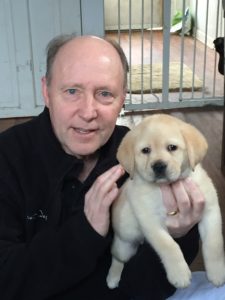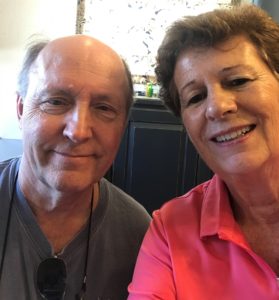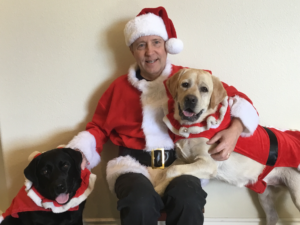Why is it that some little things, hardly noticed at the time, become life-changing events? My wife and I were enjoying some vacation time at my wife’s “happy place” – a small condo on one of the barrier islands near Charleston, SC.
It was Labor Day weekend in 2008, and I was 54 years old. We had driven down from our home in Delaware with our black Lab. We have always had dogs, as they give us great pleasure and are  great company.
great company.
That Labor Day weekend was over 12 years ago.
It is also interesting that, not unlike other Waldenstroms macroglobulinemia (WM) patients, it took a while to diagnose my condition. What I woke up to on Labor Day 2008 was a rash similar to hives. When we returned to Delaware, my primary care physician sent me to a dermatologist. The diagnosis: dry skin.
During the ensuing weeks and months, the rash came and went, more or less randomly. An increasing amount of night sweats, lots of congestion, sore throats and swelling in my ankles helped to convince my internist that something else was going on. After a more extensive blood test he referred me to a hematologist. As with so many other WM patients, we soon learned about elevated levels of IgM, anemia and MGUS. Therapy initially consisted of months on oral steroids and then cyclosporine, while the diagnosis at the time evolved into probably WM and Schnitzler syndrome.
I had some symptoms of both diseases but not all the common symptoms of either disease. I have never had hyperviscosity. I did have fatigue, significant skin rash, anemia, and leg cramps at night. To date I have had five bone marrow biopsies to help confirm the diagnosis.
At this point in time we were mostly treating the clinical symptoms, knowing I was on the spectrum of WM.
Tolerating the disease the best we could, for employment reasons, we moved from Delaware to outside of NYC, where I was being seen by hematologists at Weill-Cornell Medical Center. After more tests, the diagnosis of WM was confirmed and therapy was begun to suppress the clinical symptoms as much as possible. My New York internist suggested I see an immunologist at the Brigham and Women’s Hospital in Boston, which we duly arranged.
My wife and I have moved for my jobs many times. We are currently living in our eighteenth house in our 43 years of marriage. In 2011 we moved to Boston as I switched careers to work in academia. The constant travel required by working in the pharmaceutical industry was becoming too much for me.
Since graduating from college, we have lived on the East coast, in the Midwest, in England, and now we live on the West coast. Since having WM we have lived in Delaware, outside of NYC, Boston, and now outside of Los Angeles.
For most of my career I have worked in the pharmaceutical Industry, and for the last ten years I have worked in academia. As a pharmacist I have been blessed to understand what was driving my clinical symptoms, although it wasn’t until I became a WM patient of Dr Irene Ghobrial’s at Dana-Farber that I felt my disease was finally being controlled.
Moving and changing jobs/careers is stressful, but I have always had an abundance of energy and truly liked to be productive and provide value to whichever company I was working for at the time.
Working at a School of Pharmacy in Boston and being within walking distance of Dana-Farber and Dr Ghobrial was a gift and a blessing. As a lifelong practicing Roman Catholic, my faith has been the bedrock of my belief that supports me in dealing with my daily challenges. I do not know where I would be today without my unbelievably supportive wife, Mary Ellen, and the Catholic Church.
When Dr Ghobrial took me on as a patient my IgM levels were around 1,600 and I had several clinical symptoms. She put me on six months of chemotherapy (Rituxan), and my IgM levels were reduced to between 500 and 700. Most of my clinical symptoms also receded. During the winter I still suffered from significant pain in my hands when walking from the “T” (underground) to my office. As we all know, living with a rare disease has its own set of challenges. When first diagnosed, the number of treatment options tailored for WM was limited.
 Over the past twelve years I have had tremendous support from my wife, Mary Ellen, and from my siblings, Maureen and Kevin, and from my extended family. Both Mary Ellen and I come from large families. During the six months of chemotherapy one of these family caregivers was there during every administration of chemo, keeping me company and supporting me. I enjoyed this obvious support, but perhaps equally important were the less obvious manifestations of concern such as the frequent “So how are you doing, really?” enquiries.
Over the past twelve years I have had tremendous support from my wife, Mary Ellen, and from my siblings, Maureen and Kevin, and from my extended family. Both Mary Ellen and I come from large families. During the six months of chemotherapy one of these family caregivers was there during every administration of chemo, keeping me company and supporting me. I enjoyed this obvious support, but perhaps equally important were the less obvious manifestations of concern such as the frequent “So how are you doing, really?” enquiries.
During my journey with WM since 2008, I have been blessed in that I don’t think I missed more than one or two days of work. My chemo was administered on Saturdays, and appointments with Dr Ghobrial were scheduled early in the day, and took place just down the street from the college. After chemo I had to be hospitalized overnight from a fever of unknown origin where my temperature spiked at over 103 degrees. I was able to walk from my office to the Brigham & Women’s Hospital to be admitted.
Much of my identity and mission in life has been to find value through work. When I worked in a pharmaceutical company, my commitment was to communicating accurately and responsibly the benefits of medications to health care professionals for patients. And then as an educator, it was to pass whatever knowledge and expertise I may have learned onward to the next generation of pharmacists.
When ibrutinib was approved, Dr Ghobrial put me on the drug. I have been fortunate in that it has kept my IgM levels lower and steady. I suffer a few bothersome side effects, such as brittle nails and dry and splitting finger tips in the winter months. But they are manageable. I have also been diagnosed with early-stage prostate cancer, for which we are practicing active surveillance.
As I near retirement, I will need to find meaning in different ways – say, by adding value and finding challenges through volunteering or perhaps working part time in an area in which I find deep meaning. Returning to the East coast also is important to me.
During the early stages of the disease I did not worry about things like “retirement”. At the time I was unsure I even would have a formal retirement, and between family and work responsibilities and managing the disease, I didn’t have time to give it much thought.
The wonderful thing about the dedication of people like Dr Ghobrial and her team is the recognition that patients like me are encouraged to think about transitioning into a period of retirement. More to the point, while I do believe in heaven, I am in no rush to get there if I am able to stay here on earth a bit longer.
Recently I have been reading “What Color is Your Parachute for Retirement?” by John Nelson and Richard Bolles. For me, this is a wonderful way to think about all aspects of moving through life’s cycles and especially my Phase III.
 When I was a younger man, a friend told me about the “four Fs” he used to guide him in his life – Faith, Family, Friends and the Firm. These concepts, in this order, have helped me to orient and prioritize my life. Although the Firm has always played the most pressing role in my daily habits, in what I have done, and in where we have lived, I recognize that I could not have prospered these past twelve years absent my wife, my family and my faith.
When I was a younger man, a friend told me about the “four Fs” he used to guide him in his life – Faith, Family, Friends and the Firm. These concepts, in this order, have helped me to orient and prioritize my life. Although the Firm has always played the most pressing role in my daily habits, in what I have done, and in where we have lived, I recognize that I could not have prospered these past twelve years absent my wife, my family and my faith.
I am hopeful that retirement will allow a better realignment of the four Fs. I certainly am looking forward to finding out.
Bernie Tyrrell
La Verne, CA
December 2020

